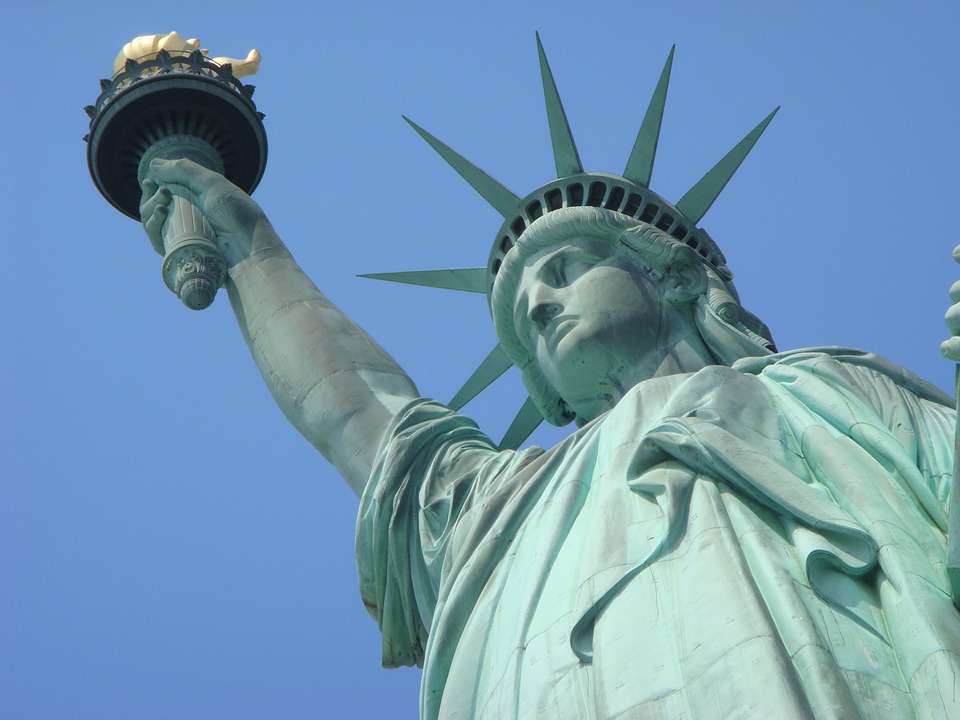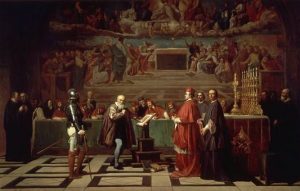On October 28, 1886, a 240-foot tall structure originally named “Liberty Enlightening the World” was revealed to an audience on Ellis Island in New York. This was the tallest structure in New York City, and it is still a great symbol in America today.1 Who would have known that a French sculptor and a French scholar would want to commemorate America for being a free nation for 100 years. These two individuals go by the names Frederic Auguste Bartholdi and Edouard-Rene Laboulaye.2 These two men met and created a sketch for the statue and wanted it to be a symbol of a “freedom-loving republic, a government in which power lay in the hands of the people, instead of a king.”3 The statue would also symbolize the alliance between France and America that began during the American War of Independence against Britain. There is a misconception that the statue was built to represent a welcoming icon for immigrants; however, this was not the initial purpose of the statue.4 France built the Statue of Liberty beginning in 1875. It was made out of 450,000 pounds of copper and steel. It was agreed by both nations that America was to be in charge of the pedestal, which weighed 27,000 tons, for the statue to rest on.5
In the construction of the statue, Bartholdi had used three hundred copper sheets to cover the entire statue. The reason why the statue appears to be green is due to its long exposure to the atmosphere over time. Something interesting is that the features of the statue’s face resemble those of Bartholdi’s mother and the arms resemble those of his wife. The Statue of Liberty is also presented wearing a long robe, which was influenced by ancient Greek and Rome attire. The purpose of this was to serve as a reminder of the ideals of that ancient era.6

The statue is carrying a tablet in her left hand with the year “1776” written on it, which is the year that Congress signed the Declaration of Independence. The significance behind this is to serve as a reminder that “all men are created equal.” It also reinforces the idea that if the government fails to abide by the natural rights of “life, liberty, and the pursuit of happiness,” then the citizens have the right to establish a new government by overthrowing the current one. This tablet also serves as a religious reminder of the Ten Commandments that Moses received when God revealed himself to him on Mount Sinai. The torch that is held in Liberty’s right hand symbolizes the light that the United States carries for the entire world. This suggests that nations should follow America’s political system, according to the French architects. She is also wearing a crown with sun rays beaming from it called a “diadem.” This refers to the ancient sun god, Helios.7
In 1884, the entire statue was done being constructed in France; however, due to its large size, it was packed into two hundred cases to be transported to New York.8 The place where the statue was assembled was Ellis Island. The statue is known as the “centerpiece of a magical American place,” since her popularity will grow through being imaged in magazines, newspapers, postcards, among other things.9 One issue with building the statue was the funding for the statue’s pedestal, since the U.S. government was not willing to pay for the construction of it. One way this was done was by fundraising and donations from various contributors, such as Joseph Pulitzer and Emma Lazarus. Pulitzer published in the New York World newspaper asking for donations for this statue. Lazarus wrote a poem at a fund-raising auction to help the funding of the statue’s pedestal.10
The unveiling of the statue was on a foggy, raining day on October 28, 1886. Millions of people witnessed this revelation and took part in a parade held in Manhattan. The President at the time was Grover Cleveland. He gave a speech at the ceremony about freedom and America’s democracy. However, immigration was not mentioned in this speech. The Statue of Liberty was the first major icon that immigrants would see as they came to America. The Statue of Liberty is an important icon in American history and is still a valued symbol today. The story behind its development and upbringing involved the interaction between France and the U.S. The purpose of the construction of this statue is to recognize America’s political system, its dependence on the ideals of freedom, and how America serves as a symbol of hope and a new start for immigrants.11
- Dictionary of American History, 2003, s.v. “Statue of Liberty,” by John Higham. ↵
- UXL Encyclopedia of U.S. History, 2009, s.v. “Statue of Liberty,” by Sonia Benson, Daniel E. Brannen, Jr., and Rebecca Valentine. ↵
- James L. Outman, Statue of Liberty In U.S. Immigration and Migration Reference Library (Detroit: UXL, 2004), 364. ↵
- James L. Outman, Statue of Liberty In U.S. Immigration and Migration Reference Library (Detroit: UXL, 2004), 364-365. ↵
- Dictionary of American History, 2003, s.v. “Statue of Liberty,” by John Higham. ↵
- James L. Outman, Statue of Liberty In U.S. Immigration and Migration Reference Library (Detroit: UXL, 2004), 366-367. ↵
- James L. Outman, Statue of Liberty In U.S. Immigration and Migration Reference Library (Detroit: UXL, 2004), 368-369. ↵
- James L. Outman, Statue of Liberty In U.S. Immigration and Migration Reference Library (Detroit: UXL, 2004), 369. ↵
- Dictionary of American History, 2003, s.v. “Statue of Liberty,” by John Higham. ↵
- James L. Outman, Statue of Liberty In U.S. Immigration and Migration Reference Library (Detroit: UXL, 2004), 365-370. ↵
- James L. Outman, Statue of Liberty In U.S. Immigration and Migration Reference Library (Detroit: UXL, 2004), 370-374. ↵



93 comments
Eric Ortega Rodriguez
I have always wanted to visit the Statue of Liberty so reading this article is great because I get to learn more about a place before I go visit. I was surprised to read that the Statue of Liberty was a gift from the French. I also did not know that it was made from a tremendous amount of copper and steel. This article was very well written with good image selection. Good work.
Lyzette Flores
I believe many Americans don’t know the true story behind the statue of liberty including myself, therefore, I am glad I came across this article. The statue of liberty is a very popular symbol here in the United States. I’ve always wanted to visit New York and while being there I totally want to visit the statue. Overall I enjoyed reading the article as I did learn from it.
Yadira Chavez
Wow, this article is so neat. The statue of liberty gets its fair share of screen time for popular movies, shows, and tours in New York. It is a representation of the United States that most people recognize, and it was not even made by us. France was very nice in using so many resources and time and money just to send it to us. They didnt even have tools that we do to put it together, and that is such a neat topic to write about.
Sienna Guerra
I have never had the privilege of going to see the Statue of Liberty but my older sister did and she told me all about it. It is nice reading the same things that my sister was told at the tour of the Statue. She had told me how the arms and face of the statue were to resemble Bartholdi’s mother and wife. Also, I knew that she was holding the Declaration of Independence and also the importance of her robe and torch. It is so interesting on how much the Statue actually weighs and how much copper was used.
Eric Ortega Rodriguez
Wow, this was an extremely fascinating article. I had heard before that the Statue of Liberty was a gift from the French but did not exactly know the entire backstory for this. I found it interesting that it was made from 450,000 pounds of copper and steel. As well as that the message of welcoming immigrants was not the initial purpose of the statue, however, over time it has begun to reveal that message. Overall, very well written article and interesting to read, especially since the Statue of Liberty is a representation of what it means to live in the United States, which is to have the rights life, liberty, and the pursuit of happiness.
Gabriela Ochoa
This is a very cool story, I have never heard of the story of how the statue of liberty was made, by who, and why. I’ve read another article that had a similar story to the creation that it was built by people who weren’t from American but felt that it need something to commemorate it. I found it interesting that it was built in France and divided into many pieces in order to transport it. Also that the features of the statue itself were based off of real people. Once again really great article I learned quite a few things from it.
Lynsey Mott
To this day, I did not know the story behind the Statue of Liberty, I knew it was a gift from the French. But other than accepting the gift, it seemed like the United States didn’t want anything to do with the gift, like them not wanting to help fund the making of the Statue of Liberty. I do find it interesting though that the face resembles his mother and the hands like his wife. It really shows him connecting France and America together, because although it is in America it has French people as a template on it.
Peter Coons
The misconceptions surrounding Lady Liberty’s construction will most likely permeate for decades to come. Many people don’t know the story of how the statue came to be, let alone that is was a gift from the French. This article does a fantastic job of giving a short, yet concise history of the statute and it’s place in our popular culture, especially that among immigrants to this country.
Anna Guaderrama
I remember reading about this when I was a child but it was also the simple explanation. I loved reading this article because it gave a bit more depth and details to the significance of the Statue of Liberty. I never knew that the ‘statue was built to represent a welcoming icon for immigrants’ was a misconception. Overall, I found this article very fascinating and learned so much that I had never known about.
Rafael Lopez-Rodriguez
Great article! I remember visiting the Statue of Liberty during the winter break and after I saw this statue for the first time my breath was taken away. After learning the history of this statue I find it very ironic that the statue represents hope and liberty. Since immigrants arriving to the US through New York had to stop at Ellis Island, this statue was the first thing they saw giving immigrants a sign of relief. Sadly that was not the case for many immigrants as some were sent back. The history of Ellis Island and this statue is a sad and shocking one.